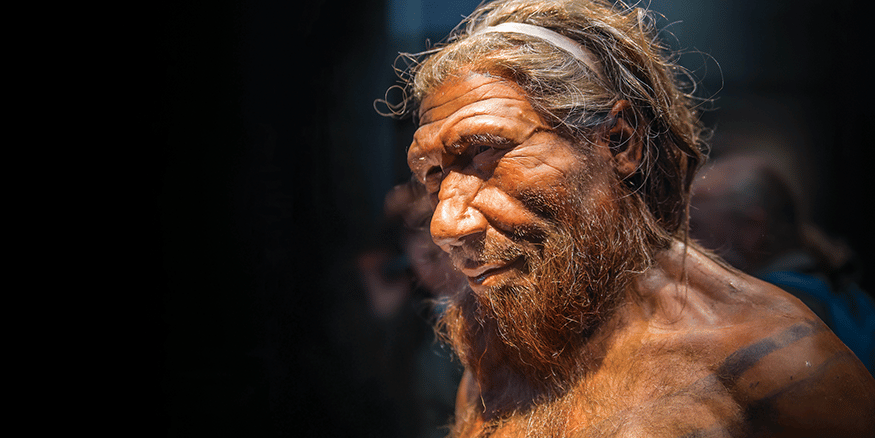
Evolution of the Human Gut Microbiota
Throughout time, we have adopted changes to our diets, environments, and lifestyle behaviours. Do you ever wonder if we’ve experienced major changes to our gut microbiota as well?
Using paleomicrobiology, which is the study of ancient microorganisms, researchers have examined Neanderthal feces to further understand the evolution of the human gut microbiota. Neanderthals are our closest evolutionary relative and they emerged at least 200,000 years ago during the Pleistocene Epoch (about 2.6 million to 11,700 years ago).1 They lived in several regions across what is now Europe and Asia. Early modern humans (Homo sapiens) followed and replaced Neanderthals around 45,000 to 35,000 years ago. Yet, current studies suggest that modern humans interbred with Neanderthals, indicating that we may not be two distinct biological species after all.
Researchers have extracted and analyzed ancient deoxyribonucleic acid (aDNA) from human dental plaque, bones, and recently, poop! Researchers analyzed ancient human stool samples, also known as paleofeces or coprolites, from the Middle Paleolithic site of El Salt in Spain.2 They found 210 bacterial species that belong to gut microbiome families associated with Neanderthals. Some of these were microorganisms that produce certain short-chain fatty acids, such as Faecalibacterium, Bifidobacterium, and Roseburia. There is growing evidence that Faecalibacterium might be a biomarker for a healthy gut microbiota. We also acquire Bifidobacterium from our mothers. Bifidobacterium can digest milk oligosaccharides and protect breastfed infants from infections and diarrhea and lower their risk for developing allergies, metabolic diseases, asthma, and other inflammatory diseases. Currently, manufacturers grow various strains of Bifidobacterium as probiotics for health benefits.
Interestingly, their study findings contribute to the growing body of evidence that Neanderthals might not have been carnivores. Roseburia can digest plant fibres and generate more energy from them. Those consuming plant-based diets today, which include grains, legumes, and fruits have an increased presence of Roseburia. Neanderthals may have also used plants for medicinal purposes, such as those containing salicylic acid (i.e., willow bark), which is the active ingredient in aspirin.3
They also found a substantial number of bacteria that reduce cholesterol. Since they are still important in our gut microbiota today, having a diet high in cholesterol might have been a part of our eating practices for tens of thousands, and perhaps millions, of years. Modern infections and illnesses may have plagued our evolutionary relatives. The researchers found disease-causing microorganisms (pathogens) that are associated with oral and dental diseases, human gangrene, and acute appendicitis.
The study concludes that we have a similar gut microbiota to Neanderthals, with many of the same major bacterial species. They believe that these species may be key components in our biology and evolutionary survival. Our ‘old friends,’ Spirochaetaceae, Prevotella, and Desulfovibrio, which are bacterial species that researchers predict to have been present throughout the evolution of mammals, were significantly present in the paleofecal samples. However, these species are increasingly disappearing among western populations today, while autoimmune and inflammatory disorders related to an imbalance of microorganisms within the gut microbiota are on the rise.
There are paleofecal samples at least 8,000 years old that researchers have not analyzed yet. Our understanding of the ancient human gut microbiota is still growing. It will be interesting to discover how their discoveries can help us use prebiotics, probiotics, and other dietary interventions for digestive diseases and disorders.
Did you know that some Neanderthals may have been redheads with pale skin? Contrary to popular belief, studies reveal that Neanderthals likely had varied hair and skin colours, potentially as diverse as ours today!4
More about the microbiome:
- Artificial Sweeteners Could Harm Gut Microbiota
- Could Mother’s Milk Shape a Newborn’s Gut Microbiome?
- Discover Your Microbiome with Injoy
- Do PPIs inhibit the gut microbiome?
- Does the Microbiota Affect Brain Health?
- Evolution of the Human Gut Microbiota
- Fibromyalgia and the Microbiome
- Food & Microbes: A Lifetime Commitment
- Gut Bacteria Protect Against Nut and Other Allergies
- Gut Bacteria’s Far-Reaching Effects
- Help for Overweight Children
- Hidradenitis Suppurativa and its Connection to IBD
- Is Your Gut Friend or Foe?
- Link Between Changing Gut Flora and Obesity
- Milk Fat: What the MFGM?
- Probiotics, Prebiotics, and the Microbiome
- The Brain-Gut-Microbiome Axis
- Your Gut Microbiota – Balanced or Not?















